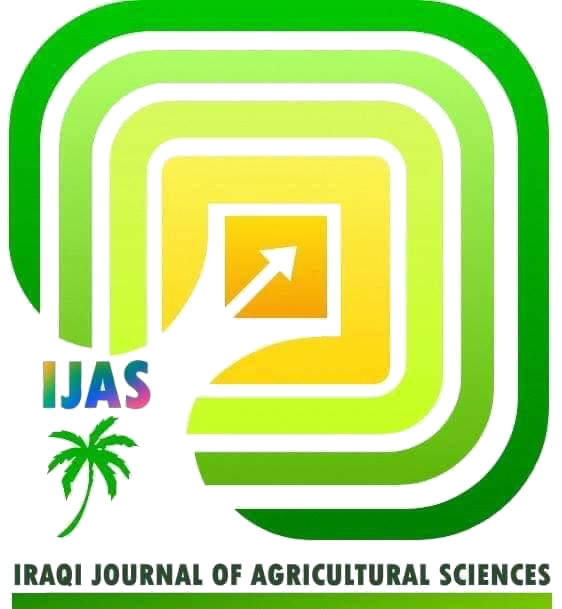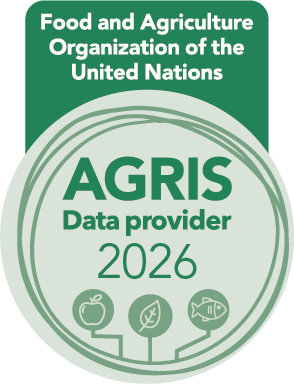STUDY OF CHEMICAL COMPOSITION AND PHYTOCHEMICAL COMPOUNDS OF LOCAL OLIVE (OLEA EUROPAEA L.) LEAVES
DOI:
https://doi.org/10.36103/2j14fx90Keywords:
Oleuropein, Antioxidant, HPLC, Chemical composition, By-productAbstract
The current study aimed to estimate the chemical composition and detect bioactive compounds, such as polyphenols and flavonoids, in the aqueous and alcoholic extracts of olive leaves. The study involved collecting olive leaves from areas in Al Za'franiya, Baghdad, Iraq. According to the chemical composition, olive leaves have a good protein content (9.89%), which may play a major role in alleviating global malnutrition. The results revealed that the leaves contain high total Ash (22.20%), carbohydrates (55.66%), energy (273.52 kcal/100g), and low total fat content (1.28%). Ethanol extract 70% contained the highest concentration of oleuropein (298.0 mg/L), which is responsible for antioxidant and pharmacological potential, as well as enhancing the immune system. The study concluded that olive leaves represent a rich and diverse natural source of active compounds, which opens horizons for their use in the food and health industries.
References
1. A.O.A.C., Official method of analysis. Association Official Analytical Chemists. 17th Ed. Virginia, U.S.A. 2000.
2. Acar-Tek, N. and D. Ağagündüz. 2020. Olive leaf (Olea europaea L. folium): Potential effects on glycemia and lipidemia. Annals of Nutrition and Metabolism, 76(1), pp.10-15. https://doi.org/10.1159/000505508
3. Al-Jowari, S.A.K., W.H. Yousif and S.A.R. Al-Obaidi. 2010. Effect of aqueous extract of olive (Olea europaea) fruit on lipid profile in female rabbits. Baghdad Science Journal, 7(4), pp.1366-1371.
4. Benavente-Garcıa, O., J. Castillo, J. Lorente, A.D.R.J. Ortuño and J.A., Del Rio. 2000. Antioxidant activity of phenolics extracted from Olea europaea L. leaves. Food Chemistry, 68(4), pp.457-462. https://doi.org/10.1016/S0308-8146(99)00221-6
5. Bennour, N., H. Mighri, H. Eljani, T. Zammouri, and A. Akrout, (2020). Effect of solvent evaporation method on phenolic compounds and the antioxidant activity of Moringa oleifera cultivated in Southern Tunisia. South African Journal of Botany, 129, 181-190. https://doi.org/10.1016/j.sajb.2019.05.005
6. Boli, E., N. Prinos, V. Louli, G. Pappa, H. Stamatis, K. Magoulas and E. Voutsas. 2022. Recovery of bioactive extracts from olive leaves using conventional and microwave-assisted extraction with classical and deep eutectic solvents. Separations, 9(9), p.255. https://doi.org/10.3390/separations9090255
7. Borjan, D., M. Leitgeb, Ž. Knez and M.K. Hrnčič. 2020. Microbiological and antioxidant activity of phenolic compounds in olive leaf extract. Molecules, 25(24), p.5946. https://doi.org/10.3390/molecules25245946
8. Boss, A., K.S. Bishop, G. Marlow, M.P. Barnett and L.R. Ferguson. 2016. Evidence to support the anti-cancer effect of olive leaf extract and future directions. Nutrients, 8(8):513. https://doi.org/10.3390/nu8080513
9. Bouaziz, M., I.v Fki, H. Jemai, M. Ayadi and S. Sayadi. 2008. Effect of storage on refined and husk olive oils composition: Stabilization by addition of natural antioxidants from Chemlali olive leaves. Food Chemistry, 108(1), pp.253-262. https://doi.org/10.1016/j.foodchem.2007.10.074
10. de Oliveira, N. M., J. Machado, M. H. Chéu, L. Lopes and M. B. Criado. 2024. Therapeutic potential of olive leaf extracts: a comprehensive review. applied Biosciences,3(3):392-425. https://doi.org/10.3390/applbiosci3030026
11. de Souza, D. R., J. L. Willems and N. H. Low. 2019. Phenolic composition and antioxidant activities of saskatoon berry fruit and pomace. Food chemistry, 290, :168-177. https://doi.org/10.1016/j.foodchem.2019.03.077
12. Di Meo, M.C., G.A. De Cristofaro, R. Imperatore, M. Rocco, D. Giaquinto, A. Palladino, T. Zotti, P. Vito, M. Paolucci and E. Varricchio. 2021. Microwave-assisted extraction of olive leaf from five Italian cultivars: Effects of harvest-time and extraction conditions on phenolic compounds and in vitro antioxidant properties. ACS Food Science and Technology, 2(1), pp.31-40.https://doi.org/10.1021/acsfoodscitech.1c00227
13. FAOSTAT 2022. FAO Stat (Rome: FAO;. Available at: http://www.fao.org/faostat. [Google Scholar]
14. Haboubi, K., A. Chetouani, B. Hammouti and A.B.D. Nandiyanto. 2022. Phytochemical study of four leaves extracts of Chamærops humilis L. from the region of Al-Hoceima, Morocco. Moroccan Journal of Chemistry, 10(4): p.10-4. https://doi.org/10.48317/IMIST.PRSM/morjchem-v10i4.34513
15. Hammoud, E.K. and A.C. Saddam. 2024. Improving nutritional and qualitative properties of wheat bread by using mallow (Malva neglecta l.) leaves powder. Iraqi Journal of Agricultural Sciences, 55(1):560-568. https://doi.org/10.36103/8p73pr77
16. Ibrahim, E.H., M.A. Abdelgaleel, A.A. Salama and S.M. Metwalli. 2016. Chemical and nutritional evaluation of olive leaves and selection the optimum conditions for extraction their phenolic compounds. J. Agric. Res. Kafr. El-Sheikh Univ, 42, pp.445-459. https://doi.org/10.21608/jsas.2016.2850
17. Kebal, L., K. Pokajewicz, , N. Djebli, N. Mostefa, A. Poliwoda, and P. P. Wieczorek, 2022. HPLC-DAD profile of phenolic compounds and In vitro antioxidant activity of Ficus carica L. fruits from two Algerian varieties. Biomedicine and Pharmacotherapy, 155,113738. https://doi.org/10.1016/j.biopha.2022.113738
18. Khanum, F., T. Zahoor, M.I. Khan, M. Asghar and S.S. Sablani. 2020. Antioxidant, antibacterial and functional-food-packaging potential of leaf extract from Pakistani olive cultivars. Pakistan Journal of Agricultural Sciences, 57(3). https://doi:10.21162/PAKJAS/20.8313
19. Khelouf, I., I. J. Karoui, A. Lakoud, M. Hammami and M. Abderrabba. 2023. Comparative chemical composition and antioxidant activity of olive leaves Olea europaea L. of Tunisian and Algerian varieties. Heliyon, 9(12). https://doi.org/10.1016/j.heliyon.2023.e22217
20. Kostelenos, G., and A. Kiritsakis. 2017. Olive tree history and evolution. Olives and olive oil as functional foods: bioactivity, Chemistry and Processing, p:1-12 https://doi.org/10.1002/9781119135340.ch1
21. Luo, S., X. Jiang L. Jia, C. Tan, M. Li, Q. Yang, Y. Du and C. Ding. 2019. In vivo and in vitro antioxidant activities of methanol extracts from olive leaves on Caenorhabditis elegans. Molecules, 24(4): 704. https://doi.org/10.3390/molecules24040704
22. Machado, Y. J., W. Murillo-Arango, and L. Hennessey-Ramos. 2022. Evaluation of peel extract of mangosteen as a dye natural and antioxidant and its use as an additive in a fruit. Iraqi Journal of Agricultural Sciences, 53(4): 857-866. https://doi.org/10.36103/ijas.v53i4.1598
23. Olmez, E., K. Vural, S. Gok, Z. Ozturk, H. Kayalar, S. Ayhan and A. Var. 2015. Olive leaf extract improves the atherogenic lipid profile in rats fed a high cholesterol diet. Phytotherapy Research, 29(10): 1652-1657. https://doi.org/10.1002/ptr.5445
24. Olszowy, M. 2019. What is responsible for antioxidant properties of polyphenolic compounds from plants?. Plant Physiology and Biochemistry, 144, :135-143. https://doi.org/10.1016/j.plaphy.2019.09.039
25. Plaskova, A., and J. Mlcek, 2023. New insights of the application of water or ethanol-water plant extract rich in active compounds in food. Frontiers in Nutrition, 10, 1118761. https://doi.org/10.3389/fnut.2023.1118761
26. Rahmanian, N., S.M. Jafari and T.A. Wani. 2015. Bioactive profile, dehydration, extraction and application of the bioactive components of olive leaves. Trends in Food Science and Technology, 42(2), pp.150-172. https://doi.org/10.1016/j.tifs.2014.12.009
27. Ridwanto, R., A. Z. Trizaldi A.S., Rani, H. M. Daulay, Nasution and D. Miswanda. 2023. Antioxidant Activity Test of Methanol Extract of Gaharu (Aquilaria Malaccensis Lam.) Bark with Dpph (1, 1 Diphenyl-2-Picrylhydrazyl) Method. International Journal of Health and Pharmaceutical (IJHP), 3(2): 232-240. https://doi.org/10.51601/ijhp.v3i2.123
28. Romani, A., F. Ieri, S. Urciuoli, A. Noce, G. Marrone, C. Nediani and R. Bernini. 2019. Health effects of phenolic compounds found in extra-virgin olive oil, by-products, and leaf of Olea europaea L. Nutrients, 11(8), p.1776. https://doi.org/10.3390/nu11081776
29. Romero-Márquez, J.M., Navarro-Hortal, M.D., Forbes-Hernández, T.Y., Varela-López, A., Puentes, J.G., Pino-García, R.D., Sánchez-González, C., Elio, I., Battino, M., R. García and S. Sánchez. 2023. Exploring the antioxidant, neuroprotective, and anti-inflammatory potential of olive leaf extracts from Spain, Portugal, Greece, and Italy. Antioxidants, 12(8), p.1538. https://doi.org/10.3390/antiox12081538
30. Şahin, S. and M. Bilgin. 2018. Olive tree (Olea europaea L.) leaf as a waste by‐product of table olive and olive oil industry: a review. Journal of the Science of Food and Agriculture, 98(4): 1271-1279. https://doi.org/10.1002/jsfa.8619
31. Sailaja, V., M. Madhu and V. Neeraja. 2016. Quantitative phytochemical analysis of some medicinal plant seed by using various organic solvents. Journal of Pharmacognosy and Phytochemistry, 5(2):30-34.
32. Salim, M., K. Samira, F. Soumia and M.M. Seghir. 2024. Evaluating olive cultivar sensitivity to Bactrocera oleae infestation and its impact on olive oil quality in the arid region of Biskra, Algeria. South Florida Journal of Development, 5(11), pp.e4685-e4685. https://doi.org/10.46932/sfjdv5n11-040
33. Šimat, V., D. Skroza, G. Tabanelli, M. Čagalj, F. Pasini, A. M. Gómez-Caravaca, and I. Generalić Mekinić, (2022). Antioxidant and antimicrobial activity of hydroethanolic leaf extracts from six mediterranean olive cultivars. Antioxidants, 11(9), 1656. https://doi.org/10.3390/antiox11091656
34. Suroowan, S., B. S Jugreet, N. B.Sauder, and M. F. Mahomoodally, 2021. Olive and Olive oil : A One Stop Herbal Solution For The Prophylaxis And Management Of Cardiovascular Disorders. In Olives and Olive Oil in Health and Disease Prevention pp. 275-290. Academic Press. https://doi.org/10.1016/b978-0-12-819528-4.00014-6
35. Tamburini, B., D. Di Liberto, G. Pratelli, C. Rizzo, L. L. Barbera, M. Lauricella,. and G. Guggino, 2025. extra virgin olive oil polyphenol-enriched extracts exert antioxidant and anti-inflammatory effects on peripheral blood mononuclear cells from rheumatoid arthritis patients. antioxidants, 14(2): 171. https://doi.org/10.3390/antiox14020171
36. Tapia-Quirós, P., A. Mir-Cerdà, M. Granados, S. Sentellas, and J. Saurina, 2025. From Waste to Resource: Exploring Green Approaches for Phenolics Recovery from Olive Leaves. Antioxidants, 14(2): 136. https://doi.org/10.3390/antiox14020136
37. Tarchi, I., M. Koubaa, F. Ozogul, M. Bouaziz, and A. Aït-Kaddour, 2025. Influence of olive leaf extract on the physicochemical properties of yogurts made from cow, sheep, and goat milk. Food Bioscience, 63, 105728. https://doi.org/10.1016/j.fbio.2024.105728
38. Teffo, T. K., Dukhan, S., Ramalepe, P., and Risenga, I. 2024. Phytochemical analysis and biological activities of various parts of Bulbine natalensis (Baker): A comparative study. Journal of Herbmed Pharmacology, 13(1), 52-60. https://doi.org/10.34172/jhp.2024.44650
39. Topuz, S., and M. Bayram, 2022. Oleuropein extraction from leaves of three olive varieties (Olea europaea L.): Antioxidant and antimicrobial properties of purified oleuropein and oleuropein extracts. Journal of food processing and preservation, 46(6), e15697. https://doi.org/10.1111/jfpp.15697
40. Udeh, V. C., E. Agboeze, E. O. Omeje, C. C. Chime, and O. C. Ike, 2022. evaluation of the phytochemical and antimicrobial activity of the fractionated methanolic leaf extract of diospyros pruessii gurke. Journal of Chemical Society of Nigeria, 47(3). https://doi.org/10.46602/jcsn.v67i3.754
41. Valera, J., G. Matilla-Seiquer, C. Oban, F. Alcaraz, and D. Rivera, 2023. Grapevine in the ancient upper Euphrates: Horticultural implications of a Bayesian morphometric study of archaeological seeds. Horticulturae, 9(7): 803. https://doi.org/10.3390/horticulturae9070803
42. You, Y., Y. Wang, M. Liang, C. Wu, Z. Huang, J. Guo and Y. Fan, 2025. The Pd nanoparticles-modified porphyrin metal-organic framework as highly efficient oxidase mimics for colorimetric quantification and discrimination of oleuropein. Colloids and Surfaces A: Physicochemical and Engineering Aspects, 136236. https://doi.org/10.1016/j.colsurfa.2025.136236
43. Zhu, L., C. Weng, X. Shen, and X. Zhu, 2024. Aptly chosen, effectively emphasizing the action and mechanism of antimycin A1. Frontiers in Microbiology, 15, 1371850. https://doi.org/10.3389/fmicb.2024.1371850
44. Zreen, Z., A. Hameed, S. Kiran, T. Farooq, and M. S. Zaroog, 2022. A comparative study of Diospyros malabarica (Gaub) extracts in various polarity‐dependent solvents for evaluation of phytoconstituents and biological activities. BioMed Research International, 2022(1), 4746223. https://doi.org/10.1155/2022/4746223
Downloads
Published
Issue
Section
License
Copyright (c) 2025 IRAQI JOURNAL OF AGRICULTURAL SCIENCES

This work is licensed under a Creative Commons Attribution-NonCommercial 4.0 International License.

2.jpg)


